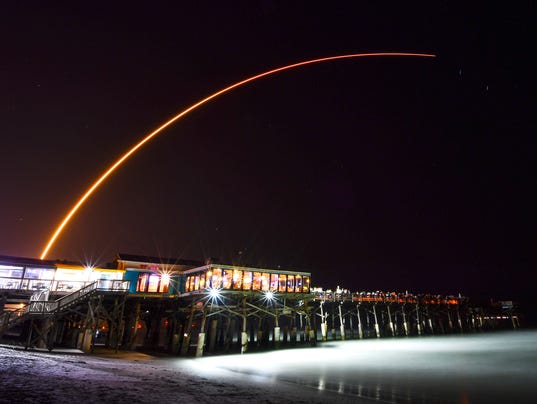Atlas V rocket blasts off with missile warning satelliteUSA Today Network
James Dean, Florida Today Published 10:21 p.m. ET Jan. 20, 2017 | Updated 13 hours ago
 A United Launch Alliance Atlas V rocket launches from Launch Complex 41 at Cape Canaveral Air Force Station Friday night with a 10,000-pound SBIRS (Space Based Infrared System satellite) designed to detect ballistic missiles. A 133 second time exposure of the launch with the Cocoa Beach Pier in the foreground.
A United Launch Alliance Atlas V rocket launches from Launch Complex 41 at Cape Canaveral Air Force Station Friday night with a 10,000-pound SBIRS (Space Based Infrared System satellite) designed to detect ballistic missiles. A 133 second time exposure of the launch with the Cocoa Beach Pier in the foreground.
(Photo: MALCOLM DENEMARK/FLORIDA TODAY)MELBOURNE, Fla. — An Atlas V rocket blasted off Friday night on a $1.2 billion mission to upgrade the satellite system charged with providing early warning if a ballistic missile — potentially one carrying a nuclear warhead — were launched at the United States.
The 19-story United Launch Alliance rocket thundered from Cape Canaveral Air Force Station at 7:42 p.m. ET, powered by a Russian main engine generating 860,000 pounds of thrust.
The Air Force’s third Space Based Infrared System satellite, or SBIRS, was dropped off in orbit 44 minutes later, on its way to a surveillance post more than 22,000 miles above the equator.
From that height, infrared sensors on the Lockheed Martin-built satellites will repeatedly scan sections of the planet, while simultaneously being able to stare at smaller areas of interest.
The sensors pick up heat from missile launches large and small, helping to warn troops in harm’s way and leaders as high up as the president and secretary of defense about where a missile started and where it is going.
“Hundreds of launchers and missiles are currently in range of our deployed forces,” said Col. Dennis Bythewood, director of the Remote Sensing Systems Directorate at Los Angeles Air Force Base.
The new warning satellites, the first of which launched in 2011, are replacing older spacecraft launched under the Defense Support Program, which dates to the early 1970s.
Beyond being on alert for direct threats to the homeland, the warning satellites have been used to track Scud missiles that Iraq fired at Israel during the first Gulf War and to detect and track North Korean missiles and rockets. They can see space launches, helping to track new satellites.
“In recent years, there's been more use of SBIRS for intelligence,” said Brian Weeden, technical adviser at the Secure World Foundation in Washington, D.C. “You can imagine that there might be a lot of things that you could detect if you have a really sensitive infrared detector staring at a spot on the Earth. What specifically SBIRS can detect, or not, is classified, but the Pentagon has talked about using SBIRS to help detect and track ISIS positions in Iraq.”
Air Force and Lockheed Martin say data from the sensors also supports civilian first responders, for example helping to identify hot spots in a forest fire.
“The sensors are quite capable," Blythewood said.
A fourth Space-Based Infrared System satellite is expected to launch this November to complete the Air Force’s global constellation.
Friday’s launch was the first of potentially more than 30 from the Space Coast this year. A SpaceX Falcon 9 rocket is targeting launch from Kennedy Space Center as soon as Jan. 30.
http://www.usatoday.com/story/news/nation-now/2017/01/20/atlas-v-rocket-blasts-off-missile-warning-satellite/96866176/
![]() New SMAC quizzes available.
New SMAC quizzes available.![]() Chess is back.
Chess is back.![]() New SMAC quizzes available.
New SMAC quizzes available.![]() Chess is back.
Chess is back.




















 Select your theme
Select your theme
